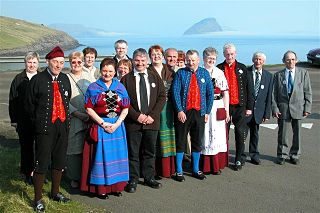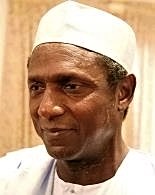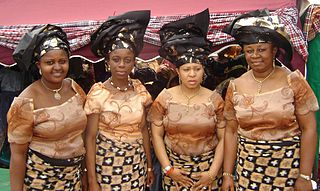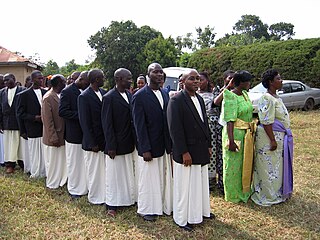
Formal wear or full dress is the Western dress code category applicable for the most formal occasions, such as weddings, christenings, confirmations, funerals, Easter and Christmas traditions, in addition to certain state dinners, audiences, balls, and horse racing events. Formal wear is traditionally divided into formal day and evening wear, implying morning dress before 6 p.m., and white tie after 6 p.m. Generally permitted other alternatives, though, are the most formal versions of ceremonial dresses, full dress uniforms, religious clothing, national costumes, and most rarely frock coats. In addition, formal wear is often instructed to be worn with official full size orders and medals.

A folk costume expresses an identity through costume, which is usually associated with a geographic area or a period of time in history. It can also indicate social, marital or religious status. If the costume is used to represent the culture or identity of a specific ethnic group, it is usually known as ethnic costume. Such costumes often come in two forms: one for everyday occasions, the other for traditional festivals and formal wear. The word "costume" in this context is sometimes considered pejorative due to the multiple senses of the word, and in such cases "regalia" can be substituted without offense.

A kaftan or caftan is a variant of the robe or tunic. Originating in Asia, it has been worn by a number of cultures around the world for thousands of years. In Russian usage, kaftan instead refers to a style of men's long suit with tight sleeves.

African clothing is the traditional clothing worn by the people of Africa.

The dashiki is a colorful garment that covers the top half of the body, worn mostly in West Africa. It is also known as a Kitenge in East Africa and is a common item of clothing in Tanzania and Kenya. It has formal and informal versions and varies from simple draped clothing to fully tailored suits. A common form is a loose-fitting pullover garment, with an ornate V-shaped collar, and tailored and embroidered neck and sleeve lines. It is frequently worn with a brimless kufi cap and pants. It has been popularized and claimed by communities in the African diaspora, especially African Americans.

A kufi or kufi cap is a brimless, short, and rounded cap worn by men in many populations in North Africa, East Africa, West Africa, and South Asia. It is also worn by men throughout the African diaspora. It is also commonly called a "topi" or "tupi" in the Indian subcontinent.

A cuff is a layer of fabric at the lower edge of the sleeve of a garment at the wrist, or at the ankle end of a trouser leg. The function of turned-back cuffs is to protect the cloth of the garment from fraying, and, when frayed, to allow the cuffs to be readily repaired or replaced, without changing the garment. Cuffs are made by turning back (folding) the material, or a separate band of material can be sewn on, or worn separately, attached either by buttons or studs. A cuff may display an ornamental border or have lace or some other trimming. In US usage, the word trouser cuffs refers to the folded, finished bottoms of the legs of a pair of trousers. In the UK, while this usage is now sometimes followed, the traditional term for the turned up trouser hem is 'turnup'.

The wrapper, lappa, or pagne is a colorful garment widely worn in West Africa by both men and women. It has formal and informal versions and varies from simple draped clothing to fully tailored ensembles. The formality of the wrapper depends on the fabric used to create or design it.

The djellaba or jillaba, also written gallabea, is a long, loose-fitting unisex outer robe or dress with full sleeves that is worn in the Maghreb region of North Africa.

Aso oke hat, known as fila in the Yoruba language, is a soft hat traditionally worn by the Yoruba people of Western Africa. It is made of hand-woven aso oke fabric, cotton, velvet, or damask. They are usually lined with cotton, but can be unlined if crafted to be worn for a single event.

The kofia is a brimless cylindrical cap with a flat crown, worn mainly by some men in East Africa.

The Taqiyah, also known as tagiyah or araqchin is a short, rounded skullcap. It is often worn for cultural or religious purposes; for example, some Muslims believe that the Islamic prophet Muhammad used to keep his head covered, therefore making it mustahabb. Muslim men often wear them during the daily prayers.
An Ethiopian suit or Eritrean suit is the name given in America to the traditional formal wear of the men of Ethiopia and Eritrea. It consists of a long sleeve, knee-length shirt, and matching pants. Most shirts are made with a Mandarin, band, or Nehru collar. The suit is made of chiffon, which is a sheer silk or rayon cloth. A shawl called a netela or a kuta is wrapped around the suit. During the opening ceremony of each Summer Olympics during Parade of Nations, the Ethiopian team marched in white suits.

A Ghanaian smock is a plaid shirt that is similar to the dashiki, worn by both women and men in Ghana. It is the most popular traditional attire in Ghana. The smock is called Bingmaa in Dagbani language, Bun-nwↃ or Bana by Mamprusis, fugu in Mosi, batakari in the southern regions, dansika in Frafra, and Banaa in Kusaal both in the upper east region. It is worn by Royals and civilians across Dagbon and other northern regions, but popular across Ghana. The smock originated in the northern region of Ghana but widely used in West Africa and diasporans across the world. The smock is not unlike the national attire of Burkina Faso known as faso dan fadi.

A kanzu is a white or cream coloured robe worn by men in the African Great Lakes region. It is referred to as a tunic in English, and as the Thawb in Arab countries. The kanzu is an ankle or floor length garment. It serves as the national costume of Tanzania as well as the Comoros, where it is called/pronounced 'Kandu' as well as thawb. The robe is also worn in some coastal Muslim regions of Tanzania and Kenya. The men of Uganda consider it their most important dress. Kanzu is a Ganda word of Swahili origin, which means "robe" or "tunic". In Tanzania, the term is used interchangeably with kaftan.

The boubou or grand boubou is a flowing wide-sleeved robe worn across West Africa, and to a lesser extent in North Africa, related to the dashiki suit.
Thawb, also spelled thobe or tobe and known by various other names in different regions, is an ankle-length robe, usually with long sleeves. It is commonly worn in the Arabian Peninsula, the Middle East, North Africa, and other neighbouring Arab countries, and some countries in East and West Africa.

Weddings in Mali involve various important customs and celebrations spread out through a number of days. Usually, the groom and the bride do not personally know the attendees that come to the wedding festivity, because Malian families tend to be very big due to polygamy. Thus weddings are a perfect occasion for all the extended family members of the couple to come for the big day. Wedding ceremonies in Bamako are a time when the community comes together to support the bride and groom's family. During this time food is given, and family from the village come to say goodbye to the bride-to-be and celebrate with the family.
The fashion industry in Nigeria plays an important cultural role and contributes significantly to the country's economy. Casual attire is commonly worn but formal and traditional styles are also worn depending on the occasion. Clothing incorporates a variety of colors, fabrics, and embellishments. Many of the component cultures of Nigeria wear styles that are unique to their tribal society and customs. Nigeria is known not only for its fashionable textiles and garments but also for its fashion designers who have increasingly gained international recognition.

Bazin stems from the Italian word "bambagia" meaning cotton wadding. It is a cotton damask or brocade fabric imported in West African countries from Europe or Asia. In Senegal, bazin fabric was introduced with the arrival of the French and was used to make a Boubou, a long loose traditional outerwear, worn by men and women mostly in West Africa and the West African Diaspora.


















